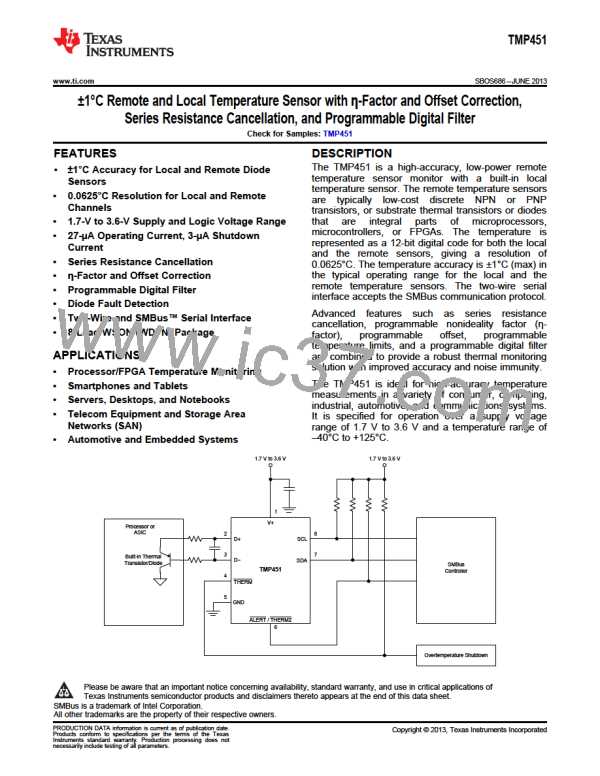TMP451
www.ti.com
SBOS686 –JUNE 2013
REMOTE SENSING
The TMP451 is designed to be used with either discrete transistors or substrate transistors built into processor
chips and ASICs. Either NPN or PNP transistors can be used, as long as the base-emitter junction is used as the
remote temperature sense. NPN transistors must be diode-connected. PNP transistors can either be transistor-
or diode-connected (see Figure 11).
Errors in remote temperature sensor readings are typically the consequence of the ideality factor and current
excitation used by the TMP451 versus the manufacturer-specified operating current for a given transistor. Some
manufacturers specify a high-level and low-level current for the temperature-sensing substrate transistors. The
TMP451 uses 7.5 μA for ILOW and 120 μA for IHIGH
.
The ideality factor (η) is a measured characteristic of a remote temperature sensor diode as compared to an
ideal diode. The TMP451 allows for different η-factor values; see the η-Factor Correction Register section.
The ideality factor for the TMP451 is trimmed to be 1.008. For transistors that have an ideality factor that does
not match the TMP451, Equation 4 can be used to calculate the temperature error. Note that for the equation to
be used correctly, actual temperature (°C) must be converted to kelvins (K).
h - 1.008
TERR
=
´ (273.15 + T(°C))
1.008
(4)
Where:
η = ideality factor of remote temperature sensor
T(°C) = actual temperature
TERR = error in TMP451 because η ≠ 1.008
Degree delta is the same for °C and K.
For η = 1.004 and T(°C) = 100°C:
1.004 * 1.008
ǒ Ǔ
273.15 ) 100°C
+ ǒ
Ǔ
TERR
1.008
TERR + 1.48°C
(5)
If a discrete transistor is used as the remote temperature sensor with the TMP451, the best accuracy can be
achieved by selecting the transistor according to the following criteria:
1. Base-emitter voltage > 0.25 V at 7.5 μA, at the highest sensed temperature.
2. Base-emitter voltage < 0.95 V at 120 μA, at the lowest sensed temperature.
3. Base resistance < 100 Ω.
4. Tight control of VBE characteristics indicated by small variations in hFE (that is, 50 to 150).
Based on these criteria, two recommended small-signal transistors are the 2N3904 (NPN) or 2N3906 (PNP).
MEASUREMENT ACCURACY AND THERMAL CONSIDERATIONS
The temperature measurement accuracy of the TMP451 depends on the remote and/or local temperature sensor
being at the same temperature as the system point being monitored. Clearly, if the temperature sensor is not in
good thermal contact with the part of the system being monitored, then there will be a delay in the response of
the sensor to a temperature change in the system. For remote temperature-sensing applications using a
substrate transistor (or a small, SOT23 transistor) placed close to the device being monitored, this delay is
usually not a concern.
The local temperature sensor inside the TMP451 monitors the ambient air around the device. The thermal time
constant for the TMP451 is approximately two seconds. This constant implies that if the ambient air changes
quickly by 100°C, it would take the TMP451 about 10 seconds (that is, five thermal time constants) to settle to
within 1°C of the final value. In most applications, the TMP451 package is in electrical, and therefore thermal,
contact with the printed circuit board (PCB), as well as subjected to forced airflow. The accuracy of the measured
temperature directly depends on how accurately the PCB and forced airflow temperatures represent the
Copyright © 2013, Texas Instruments Incorporated
Submit Documentation Feedback
21
Product Folder Links: TMP451

 TI [ TEXAS INSTRUMENTS ]
TI [ TEXAS INSTRUMENTS ]